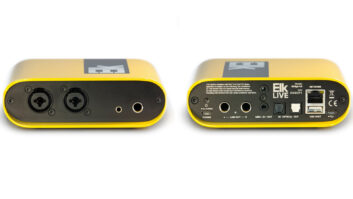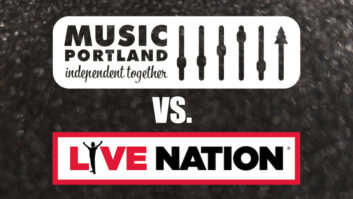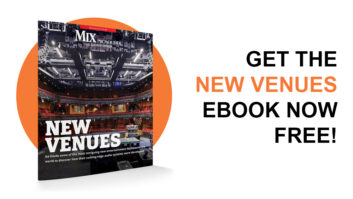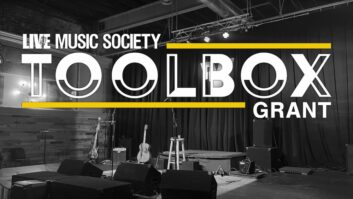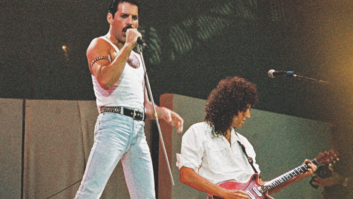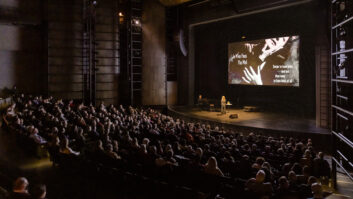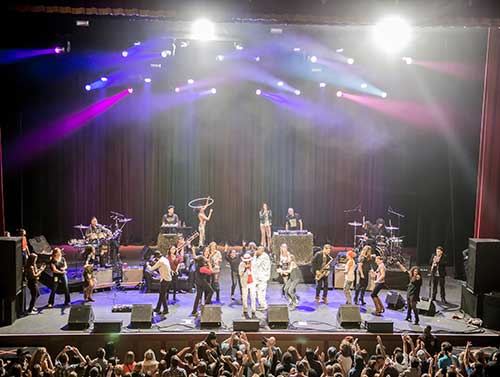
Rob Garza and Eric Hilton, the DJs, multi-instrumentalists and producers who co-founded Thievery Corporation, are marking two decades of creating and performing what some have called “world fusion music.” Beginning in March, Thievery Corporation visited a mix of festivals and mid-size indoor venues, culminating with an October 2 concert at the Greek Theatre in Los Angeles with Cypress Hill. In December, they will head to the Northeast. Mix caught Garza, Hilton and company in performance at the Fox Theater in Oakland, Calif., in late September.
When it comes to the stage, Thievery Corporation brings a large ensemble and sustained intensity to its audiences, as Garza explained to the San Francisco Chronicle in September: “‘I think that people come to our concerts sometimes, and if they haven’t seen the band they expect something very chill,’ he says. ‘But it’s very energetic and explosive. There’s a lot happening onstage with sitars and percussion and horns.’”
The task of mixing Thievery Corporation’s high-powered live show falls to front-of-house engineer Gianmaria Conti. “The sound of this band is very reggae-dub influenced with deep electronic vibes,” Conti says. “Drums and bass are the focus of the mix. You want to make people dance!”
Thievery Corporation chooses from two monitor engineers, depending on their schedules: Mike Moss or Thomas Smith, who worked at monitors for the most recent run of shows. The audio crew also comprises production manager Chip Smith, drum/DJ/keyboard tech Thanos Elias, and guitar/bass tech Terry Lapointe. The group relied on house-provided equipment over the spring and summer.
“The band is versed in many genres,” Conti says, “so the lineup is basically a drummer, a percussionist/singer, a bass player, a guitar/sitar player, sax, trumpet, the main guys [Hilton and Garza] on DJ controls and keys, and eight different singers. Depending on the city or the show, we sometimes have special guests.
“It’s a large mix with 39 to 44 channels, so I end up doing quite a lot of processing,” Conti continues. “In Oakland we used an Avid Profile at FOH and a Yamaha PM5D at monitors. I usually request Avid boards, as I like them for the workflow more than anything else—doing a lot of dub delays and effects. I like to have several controls in front of me at the same time. Also, I carry Waves plug-ins on a USB stick, which is pretty convenient and allows me to build a sound closer to the studio version.”
Conti says that because the band rarely does soundchecks, he usually does an extended line check. “I start with the drums and percussion and add EQ, compression, and some gates. When I get a good mix, I subgroup and add overall compression—usually a Waves SSL G-Master Buss Compressor or the onboard Impact [plug-in] and some reverb, of course. On bass I have a Waves C6 Multiband compressor, which works below 100 Hz, and I only add minimal EQ. I often use the Waves Bass Rider to get that full sound that you hear on the records. Recently, on guitar I started using the Waves Renaissance Axx to add a little bit of compression and grit.
“The sitar is tricky [to mix],” Conti adds. “It has a piezo [transducer], which picks up a lot of stage noise. I use two stacked EQs and Waves C6 almost as a de-esser to kill those resonating strings, which tend to feed back. I don’t do much on horns. I subgroup those channels and apply some compression and send that to an auxiliary delay. DJ controls and the keys are pretty basic.”
Conti notes that the vocal mix presents its own set of challenges “because the stage can get pretty loud. The reason we have so many wedges onstage is because almost everyone in the band moves a lot and of course wants to hear everything, everywhere. We only have few people on IEMs, so monitors are still the main source of reference. I find myself doing some extreme EQ’ing at times to fight the volume. The male vocalists use wireless Shure SM57, while the female vocalists use a Heil RC 35 capsule. The Heil RC 35 has a tighter pattern, which can be useful when dealing with a lot of bleed. I use tons of compression on the guys, as they can go from 0 to 100 in a second. The overall vocal mix is pretty wet: heavy dub-style delays with some reverb.”
